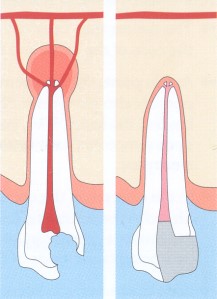
Teeth are held in the jaws by their roots. Front teeth normally have one root, but teeth further back
have more.
At the core of each tooth is a soft mass of tissue called the pulp. In a healthy tooth, the pulp contains
living fibres, cells, nerves and a blood supply, extending into the root(s) through the root canal(s).
Decay or injury can destroy the living pulp. Because dead pulp lacks a blood supply, it is more prone to infection,
leading to an abscess and toothache.
Root canal treatment (also known as root filling or endodontics)
means removing damaged or dead pulp and filling the space left. The
remaining tooth can then be repaired.
© Stalybridge Dental Care 2009 - 2024
Last updated: 28 November 2023